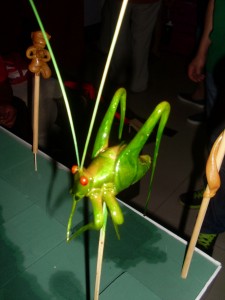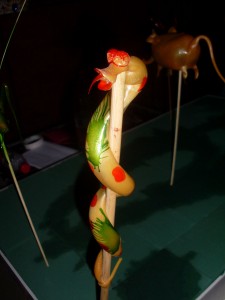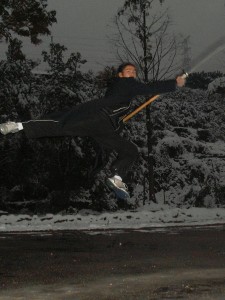 There is a common two-person Tai Chi practice walled tuishou, or push-hands. It seems, from what I have seen, that it varies in its details from school to school, but I hope the core practice is the same. Two practitioners stand and push one another, trying to maintain constant contact while looking for the opening to unbalance their partner. The secret, as far as I have grasped it, is the smooth and accurate transition from pushing to yielding in perfect synchronicity with your partner’s transition: when the other person is pushing at 80% power, you are exactly 80% yielding. When they are 30% yielding, you are exactly 30% pushing. One can not be always pushing or always yielding: obviously always yielding gets you knocked over, and always pushing seems strong but against a skilled opponent gets overbalanced. Clearly this requires great skill and sensitivity. There is no single “answer” that solves the “problem” each and every time, only by reacting well to the constantly changing situation does one stay on one’s feet.
There is a common two-person Tai Chi practice walled tuishou, or push-hands. It seems, from what I have seen, that it varies in its details from school to school, but I hope the core practice is the same. Two practitioners stand and push one another, trying to maintain constant contact while looking for the opening to unbalance their partner. The secret, as far as I have grasped it, is the smooth and accurate transition from pushing to yielding in perfect synchronicity with your partner’s transition: when the other person is pushing at 80% power, you are exactly 80% yielding. When they are 30% yielding, you are exactly 30% pushing. One can not be always pushing or always yielding: obviously always yielding gets you knocked over, and always pushing seems strong but against a skilled opponent gets overbalanced. Clearly this requires great skill and sensitivity. There is no single “answer” that solves the “problem” each and every time, only by reacting well to the constantly changing situation does one stay on one’s feet.
In this way, push-hands becomes one way to understand Taiji. Taiji is the Daoist philosophy of ever-shifting opposites. This is the philosophy the physical practice of Taijiquan attempts to capture. This practice has in turn become known (somewhat confusingly) as just Taiji, or Tai Chi (See what we did there? Made a nice little circle).
So I bring this up in an attempt to offer, once and for all, my solution to what is known in my class as, “THE HAT QUESTION.” Shifu has told us, “You must protect your health, and so you must keep your body warm in the winter.” He has also said, “Don’t wear hats during training.” So the question is this: do we or do we not wear hats to protect our health in training? And I think the answer is Taiji. Taiji the philosophy, not Taiji the physical practice — although I guess exercise helps stay warm too 🙂
If we imagine the weather as our push-hands partner, I think it becomes clear. When we are at rest, say, in our room, we are in a yielding, receptive state. The weather, cold and harsh, pushes against us. Bundling up is the passive response to cold weather, so we must bundle up. However, to maintain balance, we can’t be passive all the time, sometimes we must stoke the body’s internal fires and push back against the cold. When this happens, we don’t need or want a hat — it is a crutch that limits us and a blockage to the natural path of the body heat rising from our center.
The answer is that there is no single answer for every situation, hat or no hat. We must match our head covering to the weather and our own state of yielding or surging. Right now, are you more yin or more yang? But since Shifu is Shifu, and he expects us be fired up for training, we should be pushing against the weather during training and not wearing a hat. So no hat.
It’s funny to be writing about bundling up when it is just August and I am stewing in my own sweat every moment of every day. But the principle of trying to match my body and behavior to the circumstances still applies if I am trying to figure out if I should be strolling in a blessedly cool afternoon rain shower, or running for cover.









